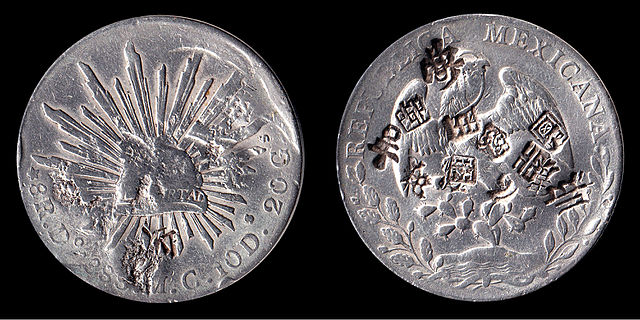Silver coins are one of the oldest mass-produced form of coinage. Silver has been used as a coinage metal since the times of the Greeks; their silver drachmas were popular trade coins. The ancient Persians used silver coins between 612–330 BC. Before 1797, British pennies were made of silver.
Silver drachma from the island of Aegina, after 404 BC
Dirham minted in the name of the Aghlabid ruler Ibrahim I (800-812) and the Abbasid Caliph al-Ma'mun (813-832). It is similar to regular Abbasid dirhams but showing early signs of emerging independent coin types.
A silver coin made during the reign of the Mughal Emperor Alamgir II
1888 Mexican 8 Real coin with Chinese chop marks
The coinage metals comprise those metallic chemical elements and alloys which have been used to mint coins. Historically, most coinage metals are from the three nonradioactive members of group 11 of the periodic table: copper, silver and gold. Copper is usually augmented with tin or other metals to form bronze. Gold, silver and bronze or copper were the principal coinage metals of the ancient world, the medieval period and into the late modern period when the diversity of coinage metals increased. Coins are often made from more than one metal, either using alloys, coatings (cladding/plating) or bimetallic configurations. While coins are primarily made from metal, some non-metallic materials have also been used.
An aluminium token coin from the 1887 American Exhibition in London. At the time, aluminium was complex to produce and more valuable than silver
A 1950 iron Swedish krona coin, with face value of 5 öre
An 1812 gold 4000 réis coin from colonial Brazil
Image: Stamp money Russia 1915 15k








